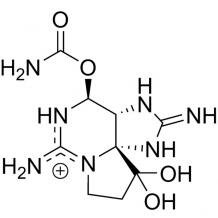Topic: Saxitoxin synthesis: from molluscs to algae
Saxitoxin has a similar molecular structure to tetrodoxin and a wide distribution amongst living organisms, with evidence that is has been recruited independently several times.
Saxitoxin is a very dangerous toxin, responsible for paralytic shell-fish poisoning in humans. Its evolutionary story is similar to tetrodotoxin, having a similar molecular structure and a wide distribution amongst living organisms, with evidence that is has been recruited independently several times.
 Saxitoxin takes its name from a genus of bivalve (Saxidomus, a saltwater clam in the family Veneridae), but is also found in other molluscs such as the octopus, as well as crustaceans and fish. Saxitoxin can also be synthesized by cyanobacteria, a macroscopic alga and dinoflagellates, the latter being the better known, especially for their association with algal blooms termed “red tides”.
Saxitoxin takes its name from a genus of bivalve (Saxidomus, a saltwater clam in the family Veneridae), but is also found in other molluscs such as the octopus, as well as crustaceans and fish. Saxitoxin can also be synthesized by cyanobacteria, a macroscopic alga and dinoflagellates, the latter being the better known, especially for their association with algal blooms termed “red tides”.
In the same way as in tetrodotoxin, precise amino acid substitution in sodium voltage-gated channel proteins can enormously reduce the effectiveness of saxitoxin, serving to render an animal immune to its effects. However, in addition to blocking sodium channels, it can also interfere with potassium and calcium channels.
Saxitoxin, therefore, exemplifies convergent evolution in several distinct respects: its similarity to tetrodotoxin, its independent recruitment by various groups of animals, the precise molecular solution in sodium channels to render the animal immune to its effects.
Cite this web page
Map of Life - "Saxitoxin synthesis: from molluscs to algae"
https://mapoflife.org/topics/topic_373_saxitoxin-synthesis-from-molluscs-to-algae/
March 3, 2021

